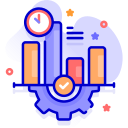From Gut Feel to Guided Foresight
Predictive analytics sifts through messy history—transactions, behaviors, seasons, surprises—to reveal probabilities that matter. Instead of debating opinions, teams compare likely futures and choose the one with the best risk-reward profile, backed by transparent assumptions and shared context.
From Gut Feel to Guided Foresight
A retail operations director once told us how “gut-led” markdowns wrecked margins during a rainy spring. A simple demand-forecasting model reframed timing and depth, saving millions. She still trusts instincts—now guided by quantified foresight, not hopeful guesswork.





